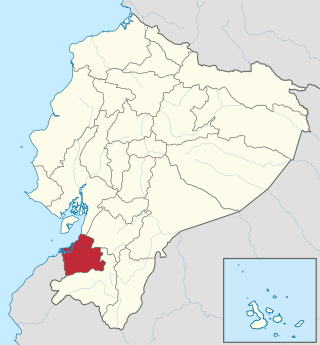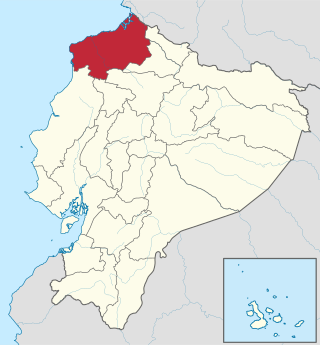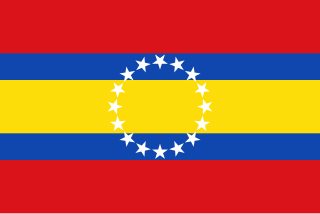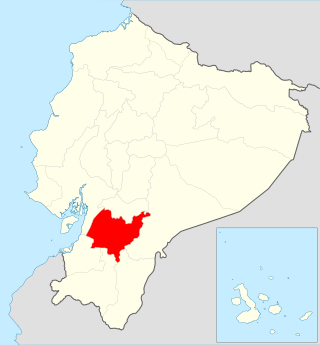
Ecuador, officially the Republic of Ecuador, is a country in northwestern South America, bordered by Colombia on the north, Peru on the east and south, and the Pacific Ocean on the west. Ecuador also includes the Galápagos Islands in the Pacific, about 1,000 kilometers (621 mi) west of the mainland. The country's capital is Quito, but its largest city is Guayaquil.

Demographic features of the population of Ecuador include population density, ethnicity, education level, health of the populace, economic status, religious affiliations and other aspects of the population.

Guayas is a coastal province in Ecuador. It is bordered to the west by Manabí, Santa Elena, and the Pacific Ocean ; to the east by Los Ríos, Bolívar, Chimborazo, Cañar, and Azuay; to the north by Los Ríos and Bolívar; and to the south by El Oro and the Pacific Ocean.

El Oro is the southernmost of Ecuador's coastal provinces. It was named for its historically important gold production. Today it is one of the world's major exporters of bananas. The capital is Machala.

Carchi is a province in Ecuador. The capital is Tulcán. The Carchi River rises on the slopes of Chiles volcano and forms the boundary between Colombia and Ecuador near Tulcan. Rumichaca Bridge is the most important land route between Colombia and Ecuador.

Esmeraldas is a province in northwestern Ecuador. The capital is Esmeraldas.

Loja Province is one of 24 provinces in Ecuador and shares its southern border on the west with El Oro Province, on the north with El Azuay, and on the east with Zamora-Chinchipe. Founded on its present site in 1548 by Captain Alonso de Mercadillo (Spanish), the site had been previously moved and rebuilt from La Toma due to earthquakes. It also is named as "Cuxibamba Valley", from the Quichua language, which means the "Smiley Valley".

Manabí is a province in Ecuador. Its capital is Portoviejo. The province is named after the Manabí people.

Quevedo is a city in Ecuador located in the Los Ríos Province. It is the seat of Quevedo Canton, a vibrant community founded in 1943. According to the latest census, Quevedo's population is 177,792. Located at 237 km SW of Quito, or, 183 km NE of Guayaquil. Quevedo is one of the fastest-growing cities in Ecuador and it is mainly known for its agricultural tradition. Quevedo's agroindustrial complex is one of the leading exporters in the world of banana, cacao, passion fruit and coffee bean. In recent years non-agricultural activities have experienced significant progress mainly in the financial and educational sectors.
Piñas is a canton in the El Oro Province, Ecuador. Its seat is Piñas. It is also known as the "Orchid of The Andes" because of the many orchids grown nearby. The town was named Piñas by Juan de Loayza, in honor of his homeland Piñas in Spain. It is located 1,126 metres (3,694 ft) above sea level.

The Province of Santa Elena is a province of Ecuador in the coastal region. Created in 2007 from territory that belonged to the Guayas Province, it is one of the two newest provinces of Ecuador, along with Santo Domingo de Los Tsáchilas. Its capital city is Santa Elena, from which the province derives its name.

Oña Canton is a canton of Ecuador, located in the Azuay Province. Its capital is the town of Oña, Ecuador. Its population at the 2001 census was 3,231.

Espejo is a canton of Ecuador, located in Carchi Province. Its capital is the town of El Ángel. Its population in the 2001 census was 13,515 and in the 2010 census was 13,364. Espejo is located in the Andes and El Ángel is situated at an elevation of 3,010 metres (9,880 ft) above sea level.

Tulcán Canton is a canton of Ecuador, located in Carchi Province. Its capital is the city of Tulcán. The population of the canton in the 2001 census was 77,175 and 86,498 in the 2010 census. The area of the canton is 1,812 square kilometres (700 sq mi).

Las Lajas Canton is a canton of Ecuador, located in the El Oro Province. Its capital is the town of La Victoria. Its population at the 2001 census was 4,781.

Zaruma Canton is a canton of Ecuador, located in the El Oro Province. Its capital is the town of Zaruma. Its population at the 2001 census was 23,407.

El Triunfo Canton is a canton of Ecuador, located in the Guayas Province. Its capital is the town of El Triunfo. Its population at the 2001 census was 34,117.

Ventanas Canton is a canton of Ecuador, located in the Los Ríos Province. Its capital is the town of Ventanas. Its population at the 2001 census was 71,145.

La Concordia Canton is a canton of Ecuador. It shares borders with the cantons of El Carmen, Chone, Pedernales, Puerto Quito, Quinindé, and Santo Domingo, which are part of the provinces of Manabí, Pichincha, Esmeraldas, and Santo Domingo de los Tsáchilas, respectively. Its capital is the town of La Concordia. Elections on whether to form part of one of those two provinces took place on February 5, 2012. The final resolution was to become part of Santo Domingo de los Tsáchilas Province, thus becoming the 2nd Canton of that province.

The Guayaquil Group was a literary group from the 1930s - mid 1940s, that emerged as a response to a chaotic social and political climate where the Ecuadorian "montubio" and mestizo were oppressed by the elite class, priests, and the police. It was composed of five main writers: Joaquín Gallegos Lara, Enrique Gil Gilbert, Demetrio Aguilera Malta, José de la Cuadra, and Alfredo Pareja Diezcanseco. Their works aimed to portray "social realism" as a form of displaying the real Ecuadorian montubio and cholo. The group eventually disintegrates after the death of two of their writers, José de la Cuadra and Joaquín Gallegos Lara, the inactivity in literature by Enrique Gil Gilbert, and the long trips away from Ecuador by Demetrio Aguilera Malta and Alfredo Pareja Diezcanseco in the mid 1940s.

















